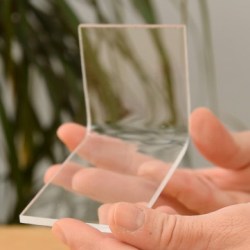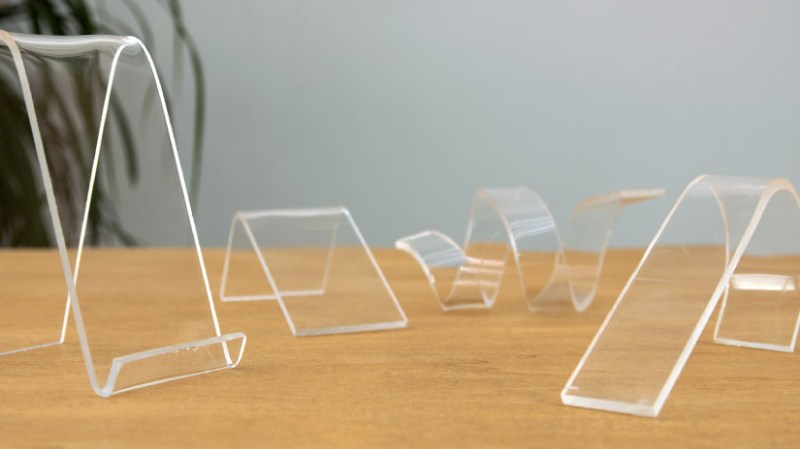Acrylic sheets are relatively inexpensive, pretty, and can be heat-shaped very effectively. There are blades and tools made specifically for cutting, heating, and bending acrylic but [Marija] shows that even without them acrylic can be cut and bent with a bit of care and patience.
 Acrylic sheets are brittle and crack easily, but a hacksaw is a good way to cut it by hand. After cutting, [Marija] uses a small portable gas stove at its lowest setting to provide gentle heat until the acrylic becomes soft, then it can be formed into different shapes using common shop and household items. It’s a process that requires patience and practice, so she shares some useful tips:
Acrylic sheets are brittle and crack easily, but a hacksaw is a good way to cut it by hand. After cutting, [Marija] uses a small portable gas stove at its lowest setting to provide gentle heat until the acrylic becomes soft, then it can be formed into different shapes using common shop and household items. It’s a process that requires patience and practice, so she shares some useful tips:
- Remove the protective film after cutting, but before heat forming. Otherwise the film will be much harder to remove.
- Heating too aggressively will result in bubbles that ruin the acrylic.
- Uneven heating will result in a bad bend, or “hot spots” which can result in bubbles as mentioned above.
- This heating method naturally softens a wide area, but it’s still possible to get straight and flat bends by using wood forms and letting the acrylic cool before moving it.
[Marija] used this method of heating and bending acrylic to complete an earlier lamp project of hers that we featured in the past. Acrylic might laser-cut beautifully, and there may be inexpensive tools for heating and bending it, but it’s always nice to have some tried and true techniques that don’t require anything special.

















A good ole heat gun works just fine, and will provide better results!!! For small stuff, a hot air rework station works a treat.
I kinda want to build one of those quick-n-dirty nichrome wire setups that basically heat a sheet of acrylic through a narrow gap in a bending brake for real clean angles. One of those was featured on Hackaday not too long ago.
https://hackaday.com/2019/04/23/get-your-acrylic-bends-just-right/
But this is even easier and allows for some free-form work. Actually now I just wanna make a cyberpunk-looking monofilament sword out of nichrome stretched across an oversized hacksaw frame or something.
As long as you’re digging into HaD archives,
here might be an idea for your sword cutting.
https://hackaday.com/2018/02/08/build-a-tiny-hot-wire-foam-cutter/
Thank you. This comment was exactly why I scrolled down to the comments. Guess I missed that article the first time around
I would hardly call tinkering with a gas flame (that I would have to go source, go to the store, etc) “tried and true” nor “no special tools required”. Just spend a few extra bucks on Amazon and get a decent, if Chinese, hot air gun…geez. If this is some ancient Eastern European technique to bend acrylic…let the tradition die.
I agree. There couldnt be a worse method. I guess if you really need to bend some, you gotta do what you gotta do, but this is silly as a guide.
How about over an electric stove burner on high? Works surprisingly well, use what you got and all that.
Yup, that works too..or in the oven if you need to do some crazy bends on a whole piece etc.
Don’t put it in the oven! The fumes are dangerous. It needs to be done in a well ventilated area
Yup, hot air gun and clamp the acrylic between wood chunks for a straight bend. Bit of gentleness, and you’re sorted.
People have been bending acrylic for a long time.
People have been using gas stoves even longer.
I’m sure people have been combining the two long enough for it to be a “tried and true” method.
As for “special tools required”, special just means that which you do not already have or are not already familiar with. That’s why we can have more than one howto video/webpage/etc.. different people have different stuff and different backgrounds.
Nah thanks. I prefer my trusty old Bender on this one :D https://photos.app.goo.gl/yJYu78N5EFmDa3YHA
“Bite my shiny acrylic…”
When we bent acrylic for light pipes we would lay the pieces (usually strips) out on a clean cookie sheet in an oven set at ~300 F. After a (surprisingly long) bit it would become rubbery, and we could stack, bend and clamp the strips pretty easily. In our case it was usually a square stack at one end to match a photomultiplier, and a edge to edge stack at the other to match a sheet of scintillator. I’m always a bit amused at the price tags for bent acrylic tables and other furniture, not to mention doubts about scratch resistance.
Sounds interesting. Any tips for how to handle/move the ~300F pieces of rubbery material safely and without leaving marks on the surface or burning my skin off?
carefully
Acrylic phone stand? No thanks. Plastic is for the wimps. I’ll use some scrap steel plates welded together with 7018 electrode, that’s trve kvlt.
trve kvlt involves replacing the smart phone with a cb radio circa 1970s.
The bubbles are caused by steam from water that is absorbed in the acrylic. Pre-heating at a lower temperature is required to dry out the acrylic. Once done, higher temps can be used to get it to a bending temperature.
Most plastics will absorb water and this is a common problem with heating and forming. Info on the drying temps for most plastics can be found with suitable google skills.
i tried something like this with my hot air rework station, but i was working with scrap acrylic left over from another project. i had pretty good results. a pid controlled oven might do it even better.
You know what? This is one of the articles where the comments are so helpful that I just couldn’t be bothered to watch the video itself. Learnt more from the comments. Thank you all!
I thought I was the only one! Same here!
Best part about Hackaday IMO
Ugh, acrylic sucks unless you need something more scratch resistant. Polycarbonate is so much better in just about every respect besides its a little more prone to scratching, but the stuff is way better at being shatter resistance and doesn’t bust when you try to drill it. Don’t ever use acrylic as a blast shield – it will shatter. Use Polycarbonate.